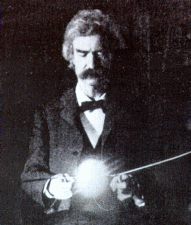Mark Twain was the  American author and creator of the fictional characters Tom Sawyer and Huckleberry Finn. Born in 1835, his real name was Samuel Langhorne Clemens and when young his family moved to live by the Mississippi river, where he grew up amongst the steamboats and characters that later peopled his novels. He worked in various positions, writing humorous articles for newspapers, as an itinerant printer and an apprentice on a steamboat, learning the art of navigation. The pseudonym “Mark Twain” was a riverman’s term meaning that the water was “two fathoms deeply” and barely safe to navigate. In 1865, his story “The Celebrated Jumping Frog of Calaveras County” gained him literary recognition throughout the country. Twain worked as a travel correspondent for a newspaper, writing numerous popular anecdotes of his experiences abroad and gave many public lectures. Marrying in 1870, he moved to a large house in Connecticut where he worked productively and happily for the next twenty years. Twain went bankrupt in the 1880s after some unsuccessful financial speculations and novels and was forced to sell the house. He travelled overseas to Europe where he lectured and achieved literary success again, thus regaining solvency and much respect for having survived his misfortune. In his final years he was greatly acclaimed and admired and he died in Connecticut in 1910.
American author and creator of the fictional characters Tom Sawyer and Huckleberry Finn. Born in 1835, his real name was Samuel Langhorne Clemens and when young his family moved to live by the Mississippi river, where he grew up amongst the steamboats and characters that later peopled his novels. He worked in various positions, writing humorous articles for newspapers, as an itinerant printer and an apprentice on a steamboat, learning the art of navigation. The pseudonym “Mark Twain” was a riverman’s term meaning that the water was “two fathoms deeply” and barely safe to navigate. In 1865, his story “The Celebrated Jumping Frog of Calaveras County” gained him literary recognition throughout the country. Twain worked as a travel correspondent for a newspaper, writing numerous popular anecdotes of his experiences abroad and gave many public lectures. Marrying in 1870, he moved to a large house in Connecticut where he worked productively and happily for the next twenty years. Twain went bankrupt in the 1880s after some unsuccessful financial speculations and novels and was forced to sell the house. He travelled overseas to Europe where he lectured and achieved literary success again, thus regaining solvency and much respect for having survived his misfortune. In his final years he was greatly acclaimed and admired and he died in Connecticut in 1910.
Twain’s most popular work includes the work The Adventures of Tom Sawyer (1876) about a mischievous boy growing up in a Mississippi town in the 1830s, a nostalgic recreation of pre-Civil war life. Its humour rendering it pleasing to adult and juvenile audiences ensured it was an immediate commercial success. However, the sequel The Adventures of Huckleberry Finn (1884) is widely recognised as his finest composition. The protagonist Huck is the son of the village drunk and is uneducated, superstitious and sometimes naive. Despite this he is enduringly cheerful, tolerant and shrewd, always managing to make the right decision in the end. He escapes his violent father with Jim – a runaway slave – and they make a long journey on the Mississippi on a raft, where they meet with various people and adventures. The river is described as is Huck’s humour and vitality, expressed in a recording of vernacular speech. While often regarded as children’s novel Huckleberry Finn is subtly ironic in its humour and vernacular speech is adapted to detailed and poetic descriptions of landscapes and people. The journey on the river is shown to be one of emotional development as Huck overcomes prejudice and learns to love and respect Jim. The theme of human cruelty is present here and was to become more pronounced in old age when Twain spoke out strongly on public issues and especially to denounce imperialism.
Twain’s other significant works include A Connecticut Yankee in King Arthur's Court (1889) where American homespun ingenuity triumphs over superstitious medieval chivalry, The Tragedy of Pudd'nhead Wilson (1894) and Personal Recollections of Joan of Arc (1895) as well as various travelogues which were a popular mix of gravity and humour. Twain’s use of comedy is varied, sometimes in the fashion of Southwestern yarn spinning, sometimes burlesque and parody, pun and suchlike verbal strategies, sometimes satire or a laconic description of incredible situations.